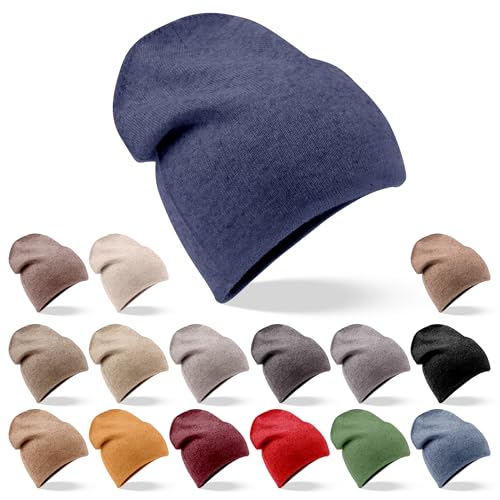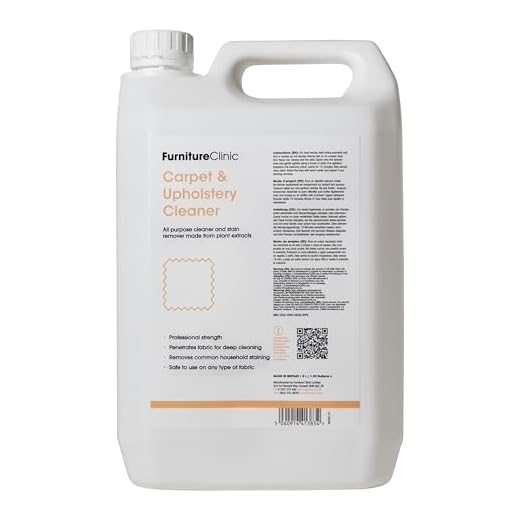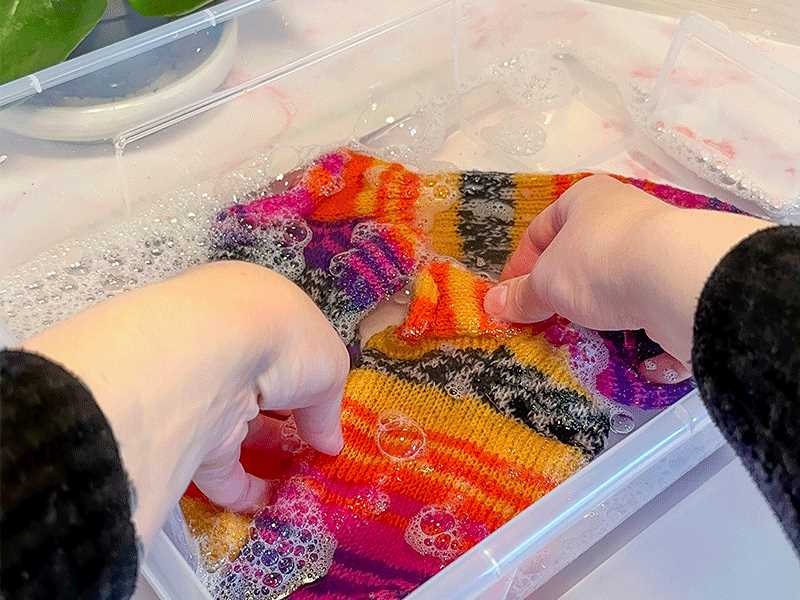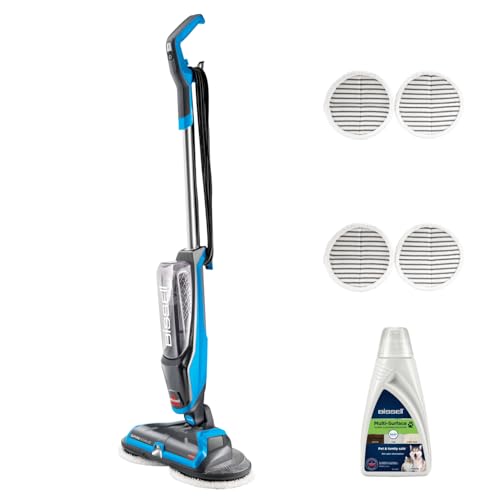




Wool is a versatile and durable fabric that is loved for its warmth and softness. However, washing wool can be a bit tricky, as it requires special care to prevent shrinking or damage. In this complete guide, we will take you through the easy steps for washing wool, so you can keep your wool garments looking and feeling their best.
First and foremost, it is important to understand that wool is a delicate fabric that requires gentle handling. This means that you should avoid using harsh detergents or machine washing your wool items. Instead, opt for a mild wool detergent that is specifically designed for delicate fabrics. These detergents are formulated to clean and care for wool without stripping it of its natural oils.
Before washing your wool items, always check the care label for any specific instructions. Some wool items may be labelled as ‘dry clean only’, in which case you should avoid washing them at home and take them to a professional cleaner instead. However, if the care label indicates that the item can be hand washed, continue reading to learn the proper steps.
When hand washing wool, fill a basin or sink with lukewarm water and add the recommended amount of wool detergent. Gently swirl the water to mix in the detergent until it is dissolved.
Must-HaveYanopurna Luxurious Cashmere Hat for All SeasonsHandmade from 100% Cashmere WoolThe Yanopurna cashmere hat offers unparalleled comfort and style, making it perfect for any occasion. Handcrafted by artisans in Nepal, it combines luxury with ethical practices.Next, place your wool item in the soapy water and gently agitate it for a few minutes. Do not wring or twist the fabric, as this can cause stretching or damage. Instead, gently squeeze the soapy water through the fabric to remove any dirt or grime.
After rinsing your wool item, gently press out the excess water without wringing or twisting. Then, lay the item flat on a clean towel and roll it up to absorb more moisture. Repeat this process with a second towel if necessary. Finally, reshape the item to its original form and lay it flat on a drying rack or towel to air dry.
By following these simple steps, you can ensure that your wool items remain soft, clean, and in excellent condition for years to come. Remember to always treat your wool garments with care and they will reward you with warmth and comfort for many seasons.
How to wash wool: The Complete Guide

Preparation

Before you begin washing your wool items, it’s essential to read the care instructions on the garment’s label.
Gather the following materials:
- Mild detergent or wool wash
- Lukewarm water
- Towels
- Soft brush or sponge
Handwashing
- Fill a basin or sink with lukewarm water.
- Add a small amount of mild detergent or wool wash to the water.
- Submerge the wool item in the water and gently swirl it around for a few minutes.
- Use a soft brush or sponge to gently spot-clean any stains or soiled areas.
- Drain the water and refill the basin or sink with clean lukewarm water.
- Rinse the wool item thoroughly in the clean water to remove any remaining detergent.
- Press the wool item against the side of the basin or sink to remove excess water. Do not wring or twist the wool.
- Place a towel on a flat surface and lay the wool item on top. Roll the towel up tightly with the wool item inside to absorb more water.
- Unroll the towel and reshape the wool item if necessary. Lay it flat on another dry towel to air dry.
Machine Washing
Note: Machine washing wool is not recommended, as it can cause shrinkage and damage. Follow the instructions on the garment’s label and use a gentle or wool cycle if allowed.
Stain Removal
If your wool item has a stain that cannot be removed with spot-cleaning, it’s best to take it to a professional dry cleaner. Attempting to remove the stain yourself may cause further damage to the wool fabric.
Storage
- Clean your wool items before storing them to prevent attracting moths.
- Store wool items in a cool, dry place away from direct sunlight.
- Avoid hanging wool items as they may stretch out of shape. Instead, fold them and store them in a drawer or on a shelf.
- Consider using moth repellents or cedar blocks to further protect your wool items.
Conclusion
With proper care and attention, washing wool can be a straightforward process. Always check the care instructions and take the necessary precautions to preserve the quality and lifespan of your wool items. When in doubt, consult a professional dry cleaner for advice.
Step 1: Preparing the Wool
Before you start washing your wool, it’s important to properly prepare it to ensure the best results. Here are some steps to follow:
- Read the care instructions: Check the label or any accompanying instructions that came with the wool for specific guidance on how to wash it. Different types of wool may require different care methods, so it’s important to follow the manufacturer’s recommendations.
- Assess the wool: Take a close look at the wool to identify any stains, spots, or areas that may require special attention. This step will help you determine whether spot treatment is needed before washing.
- Remove any accessories: Before washing, remove any buttons, zippers, or other metal or plastic accessories that may cause damage to the wool during the washing process. Set these aside to be cleaned separately if necessary.
- Gently brush or shake: Use a soft-bristled brush or gently shake the wool to remove any loose dirt, dust, or debris. This step will help minimize the amount of dirt that gets trapped in the fibers during the washing process.
- Mend any damages: If you notice any small holes or loose threads, take the time to mend them before washing. This will prevent further damage and ensure the longevity of your wool garment.
By completing these steps, you will be ready to move on to the next stage of the wool washing process. Preparing the wool properly will help ensure that it is cleaned thoroughly and remains in good condition for years to come.
Step 2: Choosing the Right Washing Method

When it comes to washing wool, it is important to choose the right method to ensure that your wool garments stay in good condition and retain their softness and shape. Here are some popular washing methods for wool:
- Hand Washing: Hand washing is often considered the best method for washing wool as it allows for more control and reduces the risk of damage. Fill a basin or sink with lukewarm water and add a small amount of wool detergent. Gently agitate the water to create suds.
- Machine Washing: Some wool garments may be suitable for machine washing, but you need to take precautions. Use a wool or delicate cycle, use cold water, and choose a gentle detergent specifically designed for wool. Place the garment in a mesh laundry bag to protect it further.
- Dry Cleaning: Dry cleaning is a safe option for delicate wool items that cannot be washed with water. Take your wool garment to a professional dry cleaner who specializes in handling wool fabrics.
It’s important to note that not all wool garments can be washed in the same way. Always check the care label on your wool garment for specific washing instructions. If in doubt, consult a professional dry cleaner or contact the manufacturer for guidance.
Next, let’s move on to Step 3: Preparing the Wool for Washing.
Step 3: Washing Wool by Hand
If you prefer to wash your wool items by hand, follow these easy steps:
- Fill a basin or sink with lukewarm water. Avoid using hot water as it can cause the wool to shrink.
- Add a gentle wool detergent to the water and mix it well.
- Place the wool item into the soapy water and gently agitate it. You can gently squeeze the fabric to ensure that the detergent penetrates all the fibers.
- Let the wool soak in the soapy water for about 5-10 minutes. This will help to loosen any dirt or stains.
- After soaking, drain the soapy water from the basin or sink.
- Rinse the wool item under cool running water until the water runs clear. Make sure to remove all the soap from the fabric.
- Gently squeeze out any excess water from the wool item. Do not wring or twist the fabric as this can cause it to stretch or lose its shape.
- Place a clean towel on a flat surface and lay the wool item on top of it.
- Gently roll up the towel with the wool item inside to remove any remaining water. Press down on the rolled-up towel to absorb the moisture.
- Unroll the towel and reshape the wool item if necessary. Lay it flat on a clean, dry towel or drying rack to air dry.
Remember to always check the care label instructions before washing your wool items to ensure you follow any specific recommendations. Washing wool by hand is a gentle and effective way to clean your wool garments while preserving their softness and shape.
Step 4: Machine Washing Wool
While hand washing is the recommended method for washing wool, some wool items can be safely machine washed. However, it is important to note that machine washing may cause more wear and tear on the wool fibers compared to hand washing. Before machine washing your wool items, be sure to check the care label for any specific instructions or recommendations.
1. Choose the right washing machine setting
When machine washing wool, it is crucial to select the appropriate setting to ensure the best results. Opt for a delicate or gentle cycle, which typically uses less agitation and lower water temperature. Avoid using a heavy-duty or regular cycle, as it may be too harsh for the delicate wool fibers.
2. Use a wool-friendly detergent
It is important to use a detergent specifically formulated for wool or other delicate fabrics. Regular laundry detergents may contain enzymes or bleaches that can damage or weaken the wool fibers. Look for a detergent that is labeled as “wool-friendly” or “gentle” to ensure the best care for your wool items.
3. Turn the item inside out
Prior to placing your wool item in the washing machine, turn it inside out. This helps to protect the outer layer of the fabric from excessive agitation and direct contact with the water. It can also help to preserve the color and shape of the item.
4. Use cold water
When machine washing wool, always use cold water. Hot water can cause the wool fibers to shrink, felt, or become misshapen. Cold water helps to preserve the integrity and structure of the wool fabric.
5. Place the item in a mesh laundry bag
To provide additional protection for your wool item, consider placing it in a mesh laundry bag. This can prevent any excessive stretching, tangling, or damage during the washing process. Ensure that the bag is large enough to accommodate the item without overcrowding.
6. Avoid using fabric softener

While fabric softeners can leave your clothes feeling soft and smelling fresh, they are not recommended for wool items. Fabric softeners can coat the wool fibers, making them less breathable and reducing their natural wicking properties. Avoid using fabric softener when machine washing wool.
7. Air dry the wool item
After the machine washing cycle is complete, remove the wool item from the machine and gently reshape it if necessary. It is important to air dry wool items rather than using a dryer. Hang the item on a drying rack or lay it flat on a clean towel away from direct sunlight or heat sources. Allow the item to dry completely before storing or wearing.
By following these steps, you can safely machine wash your wool items while minimizing the risk of damage. However, it is always recommended to check the care label and perform a spot test on a small, inconspicuous area before machine washing your wool items.
Step 5: Drying and Storing Wool
Properly drying and storing your wool items is essential for maintaining their quality and longevity. Follow these steps to ensure your wool stays in great condition for years to come.
1. Drying Wool
After washing your wool items, gently squeeze out any excess water. Avoid wringing or twisting the fabric, as this can cause stretching and damage. Lay the items flat on a clean, absorbent towel, and roll the towel up to remove more moisture.
Once the excess moisture is removed, reshape the wool items to their original size and lay them flat on a dry towel or on a drying rack. Avoid hanging wool items to dry, as this can cause them to stretch or lose their shape.
2. Air Drying
Avoid using direct heat sources such as radiators or sunlight to dry your wool items, as this can cause them to shrink or become misshapen. Instead, allow the items to air dry at room temperature. Ensure that the area is well-ventilated to prevent any musty odors from developing.
If you need to speed up the drying process, you can use a fan to help circulate the air around the wool items. This can reduce the drying time while still maintaining the item’s integrity.
3. Storing Wool
Before storing your wool items, ensure that they are completely dry. Any remaining moisture can lead to mold or mildew growth.
Store your wool items in a cool, dark, and dry place. Avoid exposure to sunlight, as it can fade the colors of the wool over time. Consider using breathable garment bags or cotton storage bags to protect the wool from dust and pests while still allowing air circulation.
Avoid storing wool items in plastic bags, as they can trap moisture and promote the growth of mold and mildew. If you want to add extra protection, you can place lavender sachets or cedar chips in the storage area to deter pests.
4. Fold and Stack

When storing your wool items, fold them neatly and stack them in an organized manner to prevent creasing or wrinkling. Avoid hanging heavy wool items, as this can cause them to stretch or lose their shape over time.
Label your storage containers or shelves to easily identify and locate your wool items when needed. This will also help you keep track of their condition and ensure that you rotate them periodically to avoid permanent creases.
Note: Before storing, be sure to check the care labels of each wool item for any additional instructions or requirements from the manufacturer.
5. Regular Inspection
Periodically inspect your stored wool items for any signs of damage, such as moth holes or discoloration. If you notice any issues, take immediate action to prevent further damage.
Consider airing out your stored wool items once every few months by hanging them in a well-ventilated area for a few hours. This will help refresh the items and prevent any trapped odors.
By following these steps for drying and storing your wool items, you can ensure that they remain in excellent condition for years to come.
FAQ
What is the best way to wash wool?
The best way to wash wool is to hand wash it in cool water using a mild detergent specifically designed for delicate fabrics. Avoid using hot water or harsh chemicals as they can damage the wool fibers.
Can I wash wool in a washing machine?
While some wool garments can be safely washed in a washing machine using the delicate or wool cycle, it is generally recommended to hand wash wool for the best results. Washing machine agitation can cause the wool fibers to shrink or felt.
Should I use fabric softener when washing wool?
No, it is not recommended to use fabric softener when washing wool. Fabric softeners can coat the wool fibers and make them less soft and resistant to pilling. Instead, you can use a wool conditioner or vinegar rinse to soften and freshen the wool.
How do I dry wool after washing?
After washing wool, it is best to carefully remove any excess water by gently squeezing or rolling the garment in a towel. Then, reshape the wool item and lay it flat on a clean towel or drying rack to air dry. Avoid hanging or wringing out wet wool as it can lose its shape.














